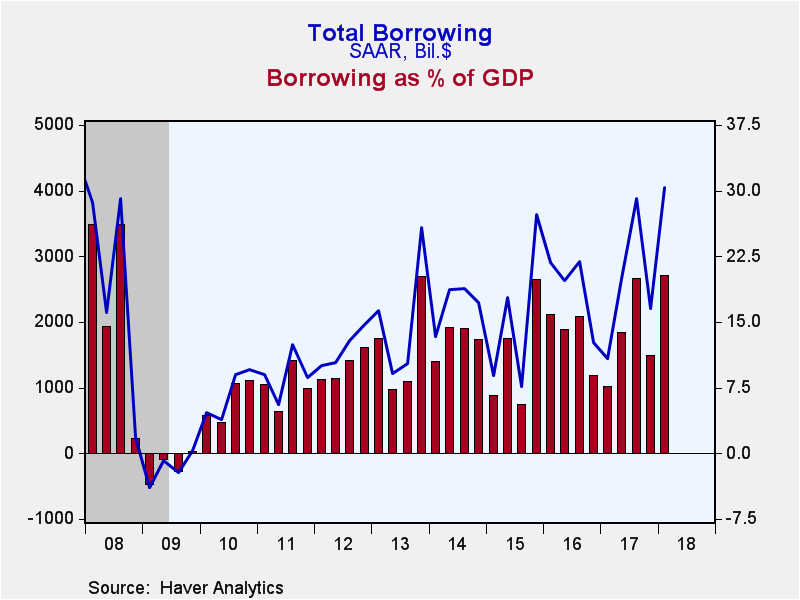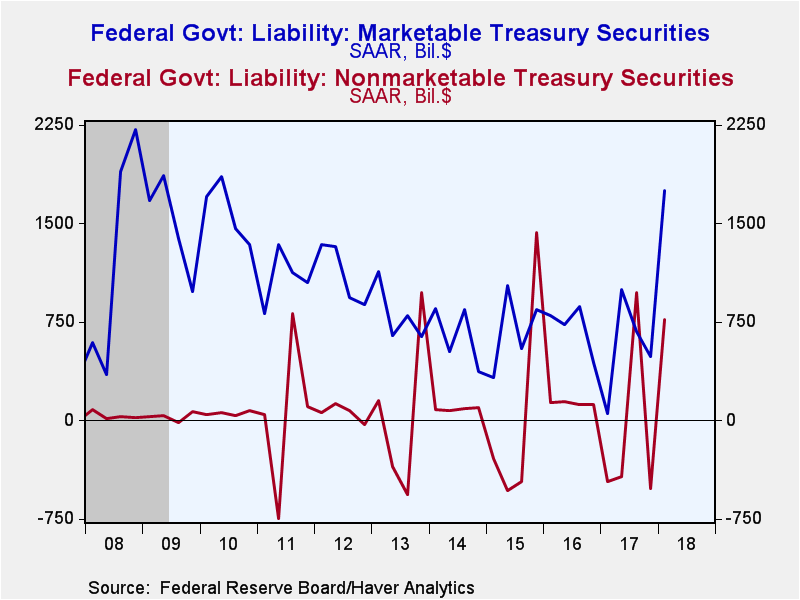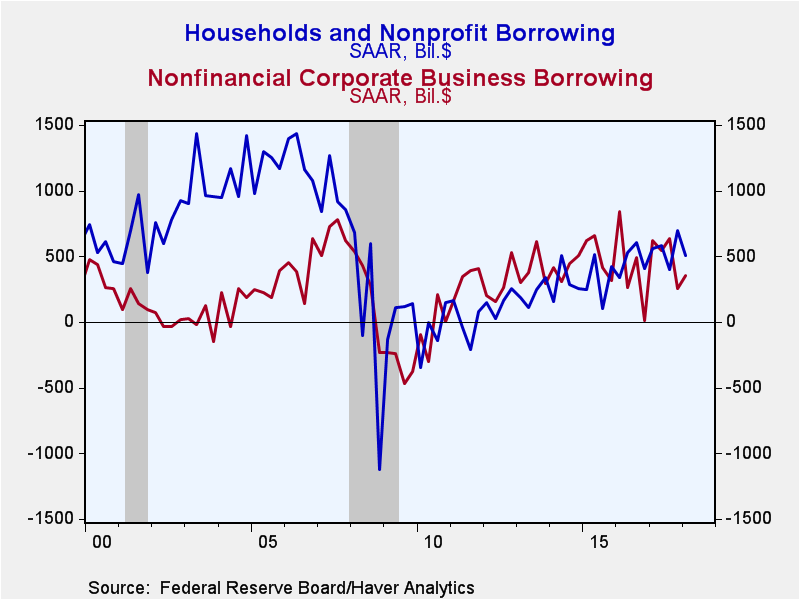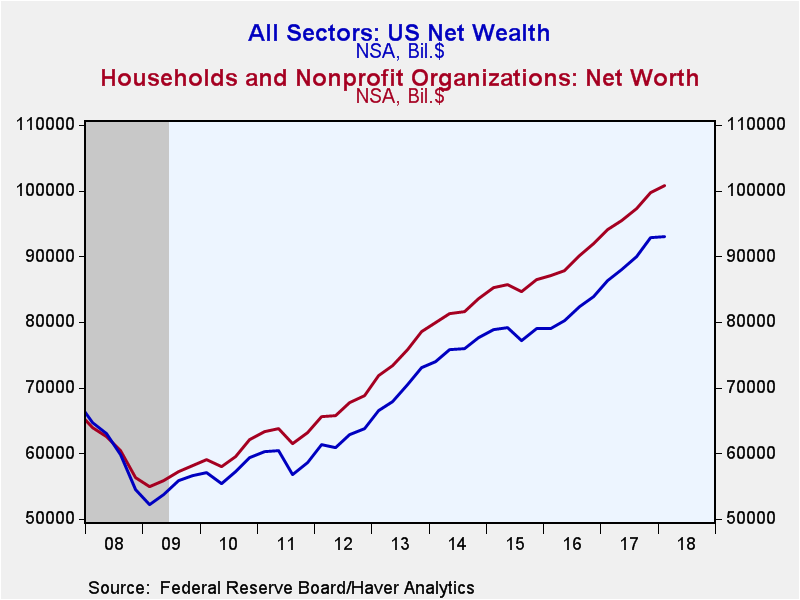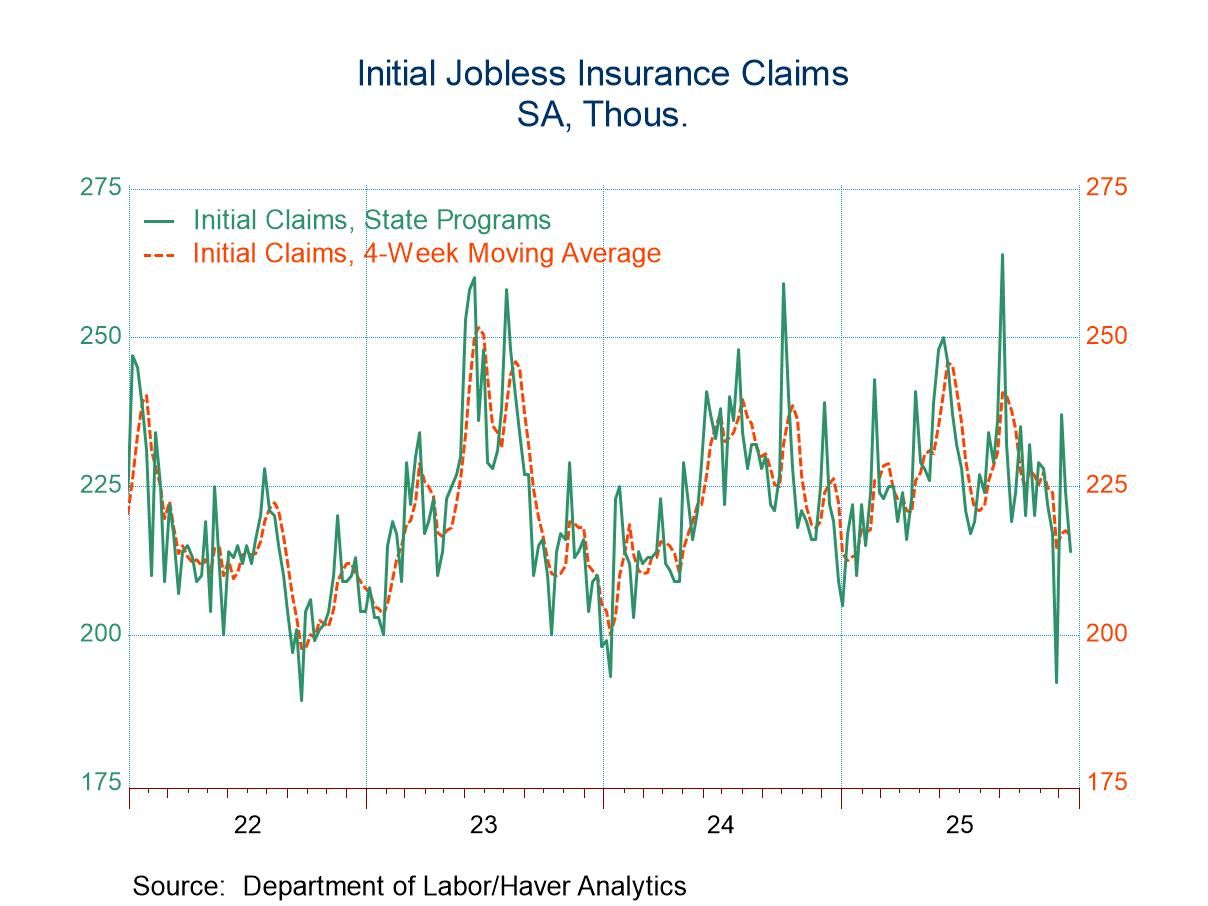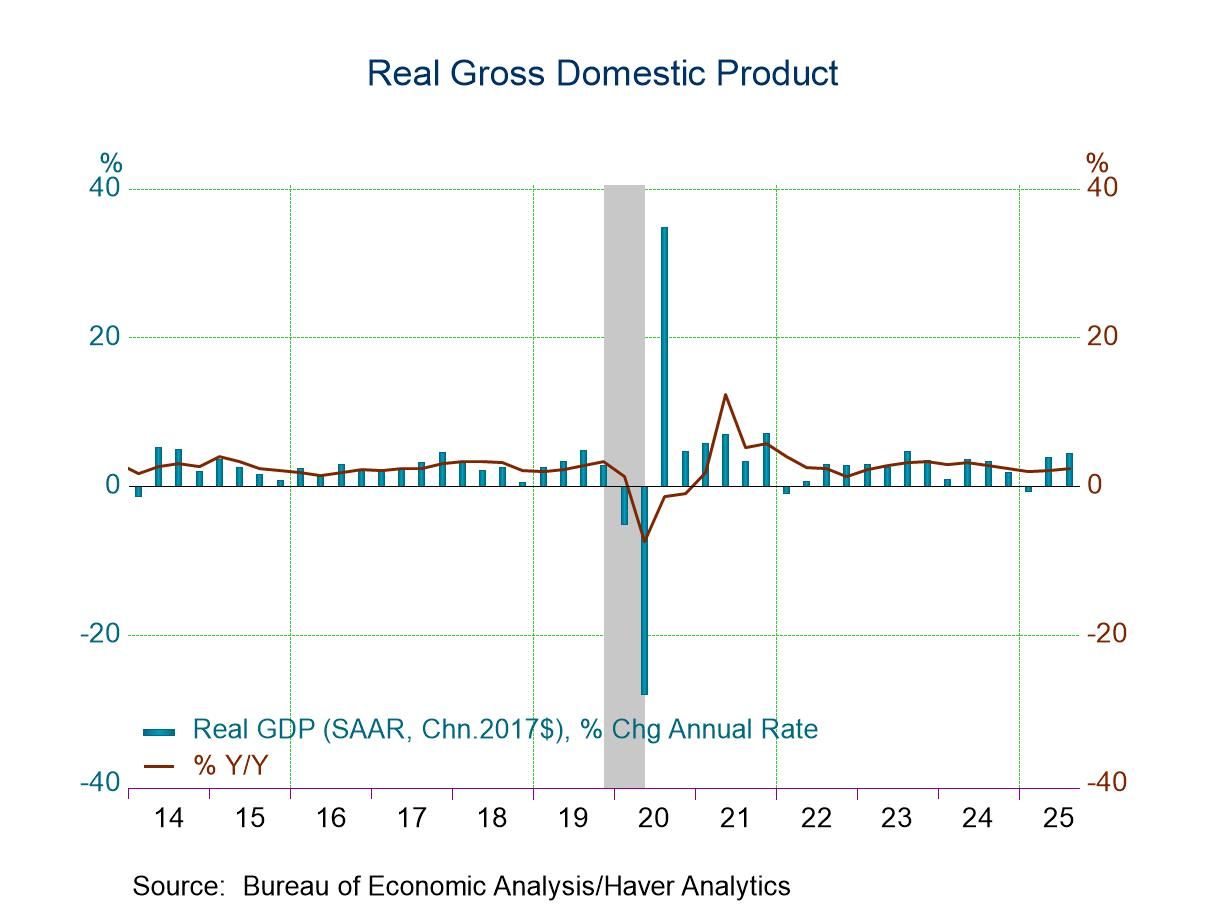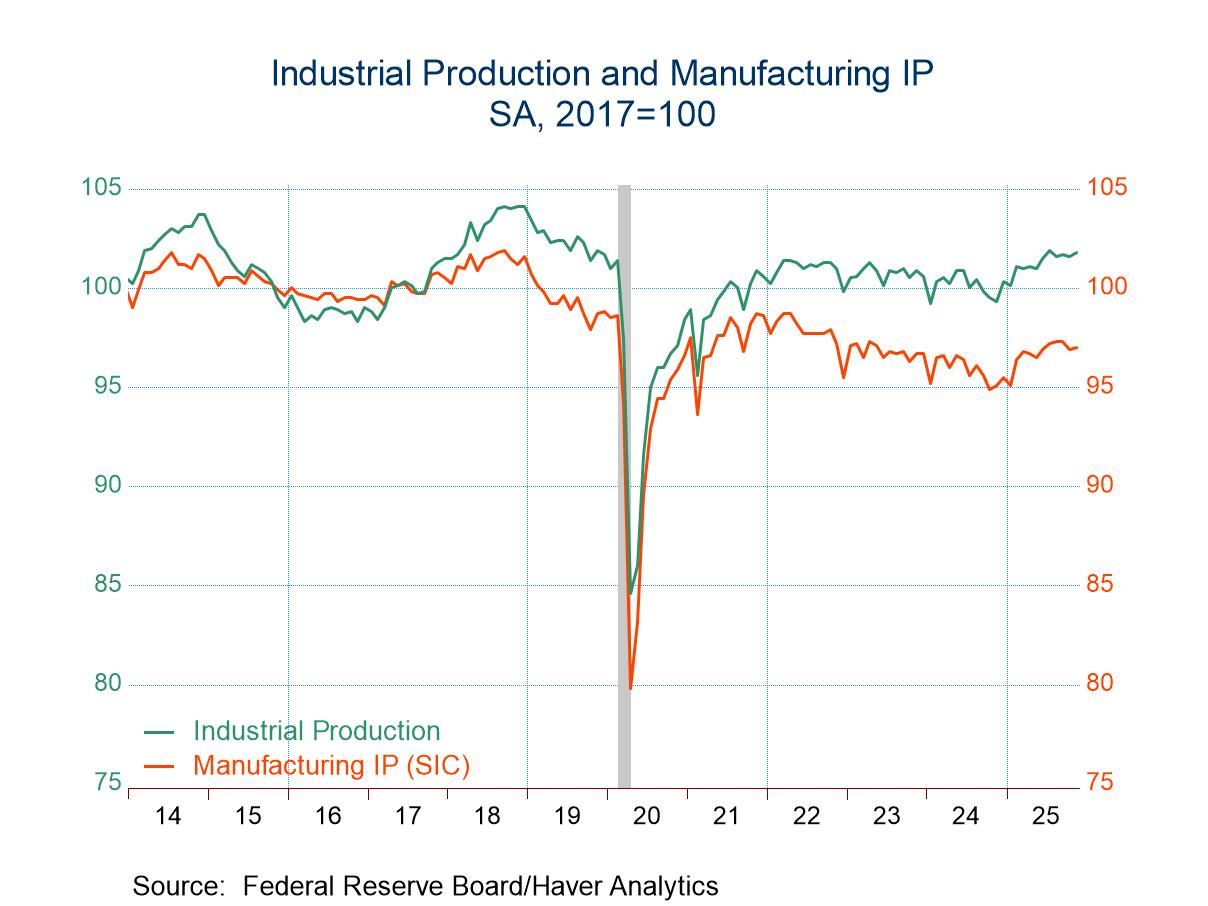 Global| Jun 07 2018
Global| Jun 07 2018U.S. Financial Accounts Show More Borrowing Due to Federal Government
Summary
Borrowing in U.S. financial markets rose markedly in Q1 2018, according to the Federal Reserve's Financial Accounts data, reaching $4,056 billion at a seasonally adjusted annual rate, almost double the Q4 2017 amount, $2,202 billion. [...]
Borrowing in U.S. financial markets rose markedly in Q1 2018, according to the Federal Reserve's Financial Accounts data, reaching $4,056 billion at a seasonally adjusted annual rate, almost double the Q4 2017 amount, $2,202 billion. The upswing came entirely from the federal government, which borrowed $2,579 billion in Q1 after paying down $32 billion in Q4. Again, these are annual rates and they are seasonally adjusted, so seasonal swings would not be the major cause of the sizable move in government borrowing. Relative to GDP, the amount of borrowing was 20.3%, the largest amount since the Great Recession.
As noted, the federal government was again the main source of change in borrowing patterns. We've described prior sizable swings in both the Treasury's marketable and nonmarketable debt. This time, both of those increased; marketable borrowing from $488 billion in Q4 to $1,749 billion in Q1. Nonmarketable borrowing shifted from the net paydown of $520 billion in Q4 to a positive $769 billion in Q1.
The two major non-governmental sectors, households and corporate business, had mixed borrowing patterns in Q1, although the amounts were quite moderate. Households borrowed $503 billion, SAAR down from $694 billion in Q4. Home mortgages increased $287 billion in Q1, less than the $338 billion the quarter before. Consumer credit grew $162 billion, less than Q4's relatively sizable $253 billion. The ratio of household borrowing to disposable income was 3.4% in Q1. This is in the range of recent years, and it contrasts with a range of 10-15% in the years just before the Great Recession.
In comparison, nonfinancial corporate business borrowing picked up somewhat, reaching $358 billion in Q1, compared to $255 billion in Q4. Corporate bond issuance increased from a marginal $60 billion in Q4 to $273 billion in Q1; although that is somewhat less than in most recent periods. Depository institution loans to business also grew more in Q1, $60 billion, versus just $7 billion in Q4. However, other loan instruments slowed such that total lending to corporate business was just $97 billion in Q1 after $152 billion in Q4.
Financial institutions, which had reduced their debt usage in Q4, cut it some more in Q1. They borrowed just $15 billion, following Q4's $253 billion. Again, these borrowing amounts are seasonally adjusted annual rates.
Press reports of these Financial Accounts highlight household balance sheets and net worth. Net worth went up slightly in Q1, reaching $100.8 trillion (amount outstanding, not seasonally adjusted). This was not due to an increase in corporate equity holdings, however; those actually eased marginally to $26.3 trillion from $26.6 trillion, including both direct holdings and mutual fund shares. Other financial assets and owners' equity in real estate did increase enough to raise total assets while total liabilities were basically unchanged, as implied above.
Net wealth of the total economy also moved little in Q1, rising from $92.9 trillion at end-Q4 to $93.1 trillion at end-Q1 (also levels, not seasonally adjusted). The total market value of domestic corporations decreased slightly to $36.2 trillion from $38.8 trillion. Net financial claims on the "rest of the world" were -$5.730 trillion at end-Q1, a slightly larger deficit than Q4's -$5.619 trillion. The remainder of the net wealth measure consists of nonfinancial assets held by households, noncorporate business and governments; these totaled $62.579 trillion on March 31, up $849 billion from December 31, 2017.
The Financial Accounts data are in Haver's FFUNDS database. Associated information is compiled in the Integrated Macroeconomic Accounts produced jointly with the Bureau of Economic Analysis (BEA); these are carried in Haver's USNA database as well as FFUNDS.
Carol Stone, CBE
AuthorMore in Author Profile »Carol Stone, CBE came to Haver Analytics in 2003 following more than 35 years as a financial market economist at major Wall Street financial institutions, most especially Merrill Lynch and Nomura Securities. She had broad experience in analysis and forecasting of flow-of-funds accounts, the federal budget and Federal Reserve operations. At Nomura Securities, among other duties, she developed various indicator forecasting tools and edited a daily global publication produced in London and New York for readers in Tokyo. At Haver Analytics, Carol was a member of the Research Department, aiding database managers with research and documentation efforts, as well as posting commentary on select economic reports. In addition, she conducted Ways-of-the-World, a blog on economic issues for an Episcopal-Church-affiliated website, The Geranium Farm. During her career, Carol served as an officer of the Money Marketeers and the Downtown Economists Club. She had a PhD from NYU's Stern School of Business. She lived in Brooklyn, New York, and had a weekend home on Long Island.


